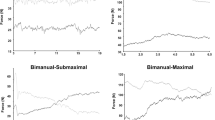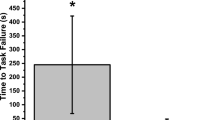Abstract
Purpose
To determine the effect of cognitive–motor dual-task load on temporal structure irregularity (complexity) of motor output and task performance of submaximal isometric contractions.
Methods
Twelve young, sedentary subjects performed handgrip isometric contractions until failure at 50% of maximal voluntary contraction under mathematical self-regulated dual-task (own pace; SDT), regulated dual-task (imposed pace; RDT), and control. Force signal complexity was calculated by sample entropy at the initial, middle, and final thirds. Task performance was assessed by muscle fatigue (time to failure and rate of median frequency of the radial flexor of the carpus), force and math task error, and self-perceived difficulty.
Results
Only RDT decreased complexity with respect to control (17.4% ± 12.6%, p = 0.005), all conditions decreased complexity by the final third (Control: 52.8% ± 18.7%, p < 0.001; SDT: 41.1% ± 32.1%, p = 0.003; RDT: 19.1% ± 21.9%, p = 0.035). Conditions did not affect time to failure, and only RDT decreased the rate of median frequency (0.1%/s ± 0.1%/s, p = 0.020). Inferior force error rate was increased by conditions (SDT: 1.5% ± 0.8%, p < 0.001; RDT: 2% ± 1.5%, p = 0.002). Math error was only augmented by RDT (from 9.9 ± 6.7 to 51.7 ± 18.8, p < 0.001), categorized as “very hard” in 85.7% of participants (p = 0.015).
Conclusion
Only the RDT condition reduced complexity and neuromuscular fatigue while increasing force error rate of the handgrip’s motor output, without affecting time to failure. A highly demanding dual-task may become a strategy to modify the organization of the hand force motor output, which may contribute to its motor adaptations.




Similar content being viewed by others
Abbreviations
- sEMG:
-
Surface electromyography
- CMDT:
-
Cognitive motor dual-task
- MVC:
-
Maximal voluntary contraction
- RDT:
-
Regulated dual-task
- RMS:
-
Root mean square
- SampEn:
-
Sample entropy
- SDT:
-
Self-regulated dual-task
References
Athreya DN, Van Orden G, Riley MA (2012) Feedback about isometric force production yields more random variations. Neurosci Lett 513:37–41. https://doi.org/10.1016/j.neulet.2012.02.002
Brown TL, Carr TH (1989) Automaticity in skill acquisition: mechanisms for reducing interference in concurrent performance. J Exp Psychol Hum Percept Perform 15:686–700. https://doi.org/10.1037/0096-1523.15.4.686
Chatain C, Radel R, Vercruyssen F et al (2019) Influence of cognitive load on the dynamics of neurophysiological adjustments during fatiguing exercise. Psychophysiology 56:e13343. https://doi.org/10.1111/psyp.13343
Cruz-Montecinos C, Calatayud J, Iturriaga C et al (2018) Influence of a self-regulated cognitive dual task on time to failure and complexity of submaximal isometric force control. Eur J Appl Physiol 118:2021–2027. https://doi.org/10.1007/s00421-018-3936-6
Evstigneeva M, Aleksandrov A, Mathiassen SE, Lyskov E (2012) Concurrent cognitive task may improve motor work performance and reduce muscle fatigue. Work 41:2893–2896. https://doi.org/10.3233/WOR-2012-0540-2893
Ghapanchizadeh H, Ahmad SA, Ishak AJ (2016) Recommended surface EMG electrode position for wrist extension and flexion. ISSBES 2015 - IEEE Student Symp Biomed Eng Sci By Student Student 108–112. https://doi.org/10.1109/ISSBES.2015.7435877
Hermens HJ, Freriks B, Merletti R et al (1999) European recommendations for surface ElectroMyoGraphy results of the SENIAM project. Roessingh Res Dev 8:13–54
Hiraga CY, Garry MI, Carson RG, Summers JJ (2009) Dual-task interference: attentional and neurophysiological influences. Behav Brain Res 205:10–18. https://doi.org/10.1016/j.bbr.2009.07.019
Hong SL, Newell KM (2008) Motor entropy in response to task demands and environmental information. Chaos. https://doi.org/10.1063/1.2979695
Keller-Ross ML, Pereira HM, Nielson KA et al (2014) Stressor-induced increase in muscle fatigability of young men and women is predicted by strength but not voluntary activation. J Appl Physiol 116:767–778. https://doi.org/10.1152/japplphysiol.01129.2013
Kida T, Kaneda T, Nishihira Y (2012) Modulation of somatosensory processing in dual tasks: an event-related brain potential study. 575–584. https://doi.org/10.1007/s00221-011-2961-z
Kuznetsov NA, Riley MA (2010) Spatial resolution of visual feedback affects variability and structure of isometric force. Neurosci Lett 470:121–125. https://doi.org/10.1016/j.neulet.2009.12.068
Li K, Marquardt TL, Li ZM (2013) Removal of visual feedback lowers structural variability of inter-digit force coordination during sustained precision pinch. Neurosci Lett 545:1–5. https://doi.org/10.1016/j.neulet.2013.04.011
McNevin NH, Wulf G, Carlson C (2000) Effects of attentional focus, self-control, and dyad training on motor learning: implications for physical rehabilitation. Phys Ther 80:373–385. https://doi.org/10.1093/ptj/80.4.373
Mehta RK, Agnew MJ (2012) Influence of mental workload on muscle endurance, fatigue, and recovery during intermittent static work. Eur J Appl Physiol 112:2891–2902. https://doi.org/10.1007/s00421-011-2264-x
Mehta RK, Cavuoto LA (2017) Relationship between BMI and fatigability is task dependent. Hum Factors 59:722–733. https://doi.org/10.1177/0018720817695194
Mehta RK, Parasuraman R (2014) Effects of mental fatigue on the development of physical fatigue: a neuroergonomic approach. Hum Fact 56:645–656. https://doi.org/10.1177/0018720813507279
Newman SD, Keller TA, Just MA (2007) Volitional control of attention and brain activation in dual task performance. Hum Brain Mapp 28:109–117. https://doi.org/10.1002/hbm.20257
Novak T, Newell KM (2017) Physiological tremor (8–12 Hz component) in isometric force control. Neurosci Lett 641:87–93. https://doi.org/10.1016/j.neulet.2017.01.034
Pereira HM, Schlinder-DeLap B, Keenan KG et al (2019) Oscillations in neural drive and age-related reductions in force steadiness with a cognitive challenge. J Appl Physiol 126:1056–1065. https://doi.org/10.1152/japplphysiol.00821.2018
Pethick J, Winter SL, Burnley M (2015) Fatigue reduces the complexity of knee extensor torque fluctuations during maximal and submaximal intermittent isometric contractions in man. J Physiol 593:2085–2096. https://doi.org/10.1113/jphysiol.2015.284380
Pethick J, Winter SL, Burnley M (2016) Loss of knee extensor torque complexity during fatiguing isometric muscle contractions occurs exclusively above the critical torque. Am J Physiol Regul Integr Comp Physiol 310(11):R1144–R1153
Pethick J, Winter SL, Burnley M (2019) Fatigue reduces the complexity of knee extensor torque during fatiguing sustained isometric contractions. Eur J Sport Sci 19(10):1349–1358
Shortz AE, Mehta RK (2017) Cognitive challenges, aging, and neuromuscular fatigue. Physiol Behav 170:19–26. https://doi.org/10.1016/j.physbeh.2016.11.034
Stefan K (2004) Modulation of associative human motor cortical plasticity by attention. J Neurophysiol 92:66–72. https://doi.org/10.1152/jn.00383.2003
Tanaka M, Watanabe Y (2012) Supraspinal regulation of physical fatigue. Neurosci Biobehav Rev 36:727–734. https://doi.org/10.1016/j.neubiorev.2011.10.004
Temprado JJ, Vieluf S, Bricot N et al (2015) Performing isometric force control in combination with a cognitive task: a multidimensional assessment. PLoS ONE 10:1–13. https://doi.org/10.1371/journal.pone.0142627
Temprado JJ, Zanone PG, Monno A, Laurent M (2001) A dynamical framework to understand performance trade-offs and interference in dual tasks. J Exp Psychol Hum Percept Perform 27:1303–1313. https://doi.org/10.1037/0096-1523.27.6.1303
Tsuchida W, Nakagawa K, Kawahara Y, Yuge L (2013) Influence of dual-task performance on muscle and brain activity. Int J Rehabil Res 36:127–133. https://doi.org/10.1097/MRR.0b013e32835acfb8
Vaillancourt DE, Newell KM (2003) Aging and the time and frequency structure of force output variability. J Appl Physiol 94:903–912. https://doi.org/10.1152/japplphysiol.00166.2002
Vanden Noven ML, Pereira HM, Yoon T et al (2014) Motor variability during sustained contractions increases with cognitive demand in older adults. Front Aging Neurosci 6:1–14. https://doi.org/10.3389/fnagi.2014.00097
Vieluf S, Temprado JJ, Berton E et al (2015) Effects of task and age on the magnitude and structure of force fluctuations: Insights into underlying neuro-behavioral processes. BMC Neurosci 16:1–17. https://doi.org/10.1186/s12868-015-0153-7
Wulf G, McNevin N, Shea CH (2001) The automaticity of complex motor skill learning as a function of attentional focus. Q J Exp Psychol Sect A Hum Exp Psychol 54:1143–1154. https://doi.org/10.1080/713756012
Acknowledgements
We thank the subjects for their willingness to participate in this study.
Author information
Authors and Affiliations
Contributions
CCM, BGG, JC, and CBB conceived and designed the research. BGG and CBB conducted the experiments. CCM, XGM, CT, JTE, and BGG analysed the data. All authors contributed to the writing of the manuscript. All authors read and approved the manuscript.
Corresponding author
Ethics declarations
Conflict of interest
BGG, CBB, JC, CT, JTE, XGM, and CCM have nothing to declare.
Ethics approval
All procedures performed in studies involving human participants were in accordance with the ethical standards of the institutional and/or national research committee and with the 1964 Helsinki declaration and its later amendments or comparable ethical standards.
Informed consent
All volunteers gave written informed consent.
Additional information
Communicated by Toshio Moritani .
Publisher's Note
Springer Nature remains neutral with regard to jurisdictional claims in published maps and institutional affiliations.
Rights and permissions
About this article
Cite this article
Guzmán-González, B., Bustos-Briones, C., Calatayud, J. et al. Effects of dual-task demands on the complexity and task performance of submaximal isometric handgrip force control. Eur J Appl Physiol 120, 1251–1261 (2020). https://doi.org/10.1007/s00421-020-04357-x
Received:
Accepted:
Published:
Issue Date:
DOI: https://doi.org/10.1007/s00421-020-04357-x




